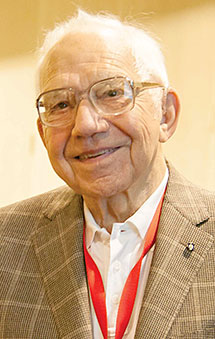Leo Leroy Beranek
DOI: 10.1063/PT.3.3737
Leo Leroy Beranek, a global leader in acoustics, noise control, and concert hall design, passed away in his home in Westwood, Massachusetts, on 10 October 2016.

Leo Leroy Beranek
BOB LOTZ

Born in Solon, Iowa, on 15 September 1914, Leo graduated from Cornell College in 1936 with a BA degree in math and physics. He was admitted into the doctoral program at Harvard University, where he worked under Frederick Hunt. His DSc degree was awarded in 1940 for his work on acoustic impedance; Leo developed a method for measuring it as part of his thesis and presented examples for many acoustical materials.
The National Defense Research Committee established in 1940 the Harvard Electro-Acoustics Laboratory, and Leo was its director until 1946. The laboratory provided civilians the opportunity to work on military acoustical problems. Lightweight, sound-absorptive materials with a high ratio of surface to volume were needed to lower noise levels in airplane cockpits. Leo worked with a manufacturer to produce the materials. He helped design headsets and other devices to allow good communication in the presence of noise. The government needed echo-free space to test high-intensity noise sources, so Leo developed fiberglass wedges for use in what became known as anechoic chambers. Such rooms are still being built and used worldwide for electro-acoustic testing and determination of the noise emissions of products. While at Harvard, Leo received a Guggenheim fellowship to write his first book, Acoustic Measurements, published in 1949. The revised edition in 1998 contained a great deal of new information.
In 1947 Leo joined the MIT faculty as an associate professor for communications engineering. He taught a course on electrical network theory in the summer of 1951 and adapted that theory to the design of electro-acoustical networks. That led to the publication of his book Acoustics in 1954. The book also contained information on noise control and especially criteria for noise-control design, one of Leo’s longtime interests. While at MIT, he established a series of noise-control courses for people working in industry. His 1960 book Noise Reduction came out of those courses. Later, his books Noise and Vibration Control in 1971 and Noise and Vibration Control Engineering: Principles and Applications with István Vér in 1992 became valuable sources of noise-control engineering information.
In 1948 Leo partnered with Richard Bolt, an MIT professor with training in physics and architecture, to found a consulting firm. Later, Robert Newman, an architect, was added, and the firm became Bolt Beranek and Newman (BBN). The first job was acoustical consulting for the United Nations building in New York. Among the many additional projects was successfully designing a very large muffler for the National Advisory Committee for Aeronautics (the forerunner of NASA) for a supersonic wind tunnel in Cleveland, Ohio. Leo described the noise situation before the muffler’s installation: “The noise sounded like a series of thunderous explosions, even at distances as far as 5 or 10 miles away.”
At the beginning of the jet age, noise from jet airplanes was rightly perceived to be louder than that from propeller planes. In his work with the Port of New York Authority, Leo established measures to reduce jet noise and, with others, developed a new noise metric called effective perceived noise level, or EPNdB, a variation of which is still used today in the certification of noise levels of commercial airplanes.
In 1955 Leo led the diversification of BBN into computer science, including hiring J. C. R. Licklider. BBN’s contract with the Advanced Research Projects Agency led to the development of a packet-switching network that became ARPANET, the precursor of the internet.
Throughout his life Leo studied and consulted on the propagation, reflection, and absorption of sound in many of the world’s best concert halls and on the effects of the sound fields on both the audience and performers. His books include Concert and Opera Halls: How They Sound (1996) and Concert Halls and Opera Houses: Music, Acoustics, and Architecture (2004).
While Leo was president of the Acoustical Society of America in 1954–55, he launched a technical journal, NOISE Control. In 1971 he and William Lang were leaders in the founding of the Institute of Noise Control Engineering (INCE-USA). During his presidency in 1972, INCE-USA established a series of international congresses called INTER-NOISE. Actions by Leo at the first congress led the federal government to pass the Noise Control Act of 1972. Leo also led the launch of the technical publication Noise Control Engineering Journal.
His final book, Acoustics: Sound Fields and Transducers, was written with Tim Mellow and published in 2012. It was a complete rewrite of the electro-acoustical and sound-field portions of his 1954 book Acoustics, with emphasis on the computer programming of the equations.
Leo received many honors and awards during his lifetime. Among them were the US President’s Certificate of Merit in 1948 for contributions to the US research effort during World War II and the National Medal of Science in 2002.
Extremely active in the affairs of the Boston Symphony Orchestra, Leo had a special concert in his honor on his 100th birthday. He was an excellent skier and used short skis long before they became popular. He particularly enjoyed skiing in the Swiss Bernese Oberland and in Alta, Utah, and continued to ski up to age 89.
Leo is greatly admired by his colleagues for his contributions to acoustics and the many initiatives he created. As a prolific author and mentor to many, he reached out to others and was willing to share his technical insights. He was a kind, thoughtful, and engaging gentleman during both social and technical occasions.
More about the Authors
George C. Maling. Brunswick, Maine.
Eric J. W. Wood. Acentech Incorporated, Cambridge, Massachusetts.
